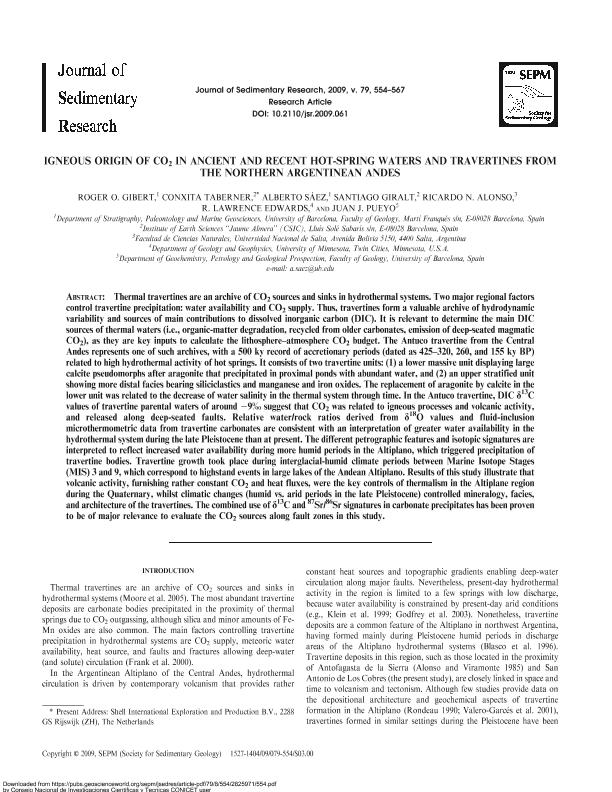Mostrar el registro sencillo del ítem
dc.contributor.author
Gibert, Roger O.
dc.contributor.author
Taberner, Conxita
dc.contributor.author
Sáez, Alberto
dc.contributor.author
Giralt, Santiago
dc.contributor.author
Alonso, Ricardo Narciso

dc.contributor.author
Edwards, Lawrence R.
dc.contributor.author
Pueyo, Juan J.
dc.date.available
2019-04-01T14:10:33Z
dc.date.issued
2009-07
dc.identifier.citation
Gibert, Roger O.; Taberner, Conxita; Sáez, Alberto; Giralt, Santiago; Alonso, Ricardo Narciso; et al.; Igneous origin of Co 2 in ancient and recent hot-spring waters and travertines from the northern argentinean andes; Society for Sedimentary Geology; Journal of Sedimentary Research - (Print); 79; 8; 7-2009; 554-567
dc.identifier.issn
1527-1404
dc.identifier.uri
http://hdl.handle.net/11336/72900
dc.description.abstract
Thermal travertines are an archive of CO 2 sources and sinks in hydrothermal systems. Two major regional factors control travertine precipitation: water availability and CO 2 supply. Thus, travertines form a valuable archive of hydrodynamic variability and sources of main contributions to dissolved inorganic carbon (DIC). It is relevant to determine the main DIC sources of thermal waters (i.e., organic-matter degradation, recycled from older carbonates, emission of deep-seated magmatic CO 2), as they are key inputs to calculate the Iithosphere-atmosphere CO 2 budget. The Antuco travertine from the Central Andes represents one of such archives, with a 500 ky record of accretionary periods (dated as 425-320, 260, and 155 ky BP) related to high hydrothermal activity of hot springs. It consists of two travertine units: (1) a lower massive unit displaying large calcite pseudomorphs after aragonite that precipitated in proximal ponds with abundant water, and (2) an upper stratified unit showing more distal facies bearing siliciclastics and manganese and iron oxides. The replacement of aragonite by calcite in the lower unit was related to the decrease of water salinity in the thermal system through time. In the Antuco travertine, DIC δ 13C values of travertine parental waters of around -9‰ suggest that CO 2 was related to igneous processes and volcanic activity, and released along deep-seated faults. Relative water/rock ratios derived from δ 18O values and fluid-inclusion microthermometric data from travertine carbonates are consistent with an interpretation of greater water availability in the hydrothermal system during the late Pleistocene than at present. The different petrographic features and isotopic signatures are interpreted to reflect increased water availability during more humid periods in the Altiplano, which triggered precipitation of travertine bodies. Travertine growth took place during interglacial-humid climate periods between Marine Isotope Stages (MIS) 3 and 9, which correspond to highstand events in large lakes of the Andean Altiplano. Results of this study illustrate that volcanic activity, furnishing rather constant CO 2 and heat fluxes, were the key controls of thermalism in the Altiplane region during the Quaternary, whilst climatic changes (humid vs. arid periods in the late Pleistocene) controlled mineralogy, facies, and architecture of the travertines. The combined use of δ 13C and 87Sr/ 86Sr signatures in carbonate precipitates has been proven to be of major relevance to evaluate the CO 2 sources along fault zones in this study.
dc.format
application/pdf
dc.language.iso
eng
dc.publisher
Society for Sedimentary Geology

dc.rights
info:eu-repo/semantics/openAccess
dc.rights.uri
https://creativecommons.org/licenses/by-nc-sa/2.5/ar/
dc.subject
Igneous Origin of Co2
dc.subject
Ancient And Recent
dc.subject
Hot Spring Waters And Travertines
dc.subject
Northern Argentinean Andes
dc.subject.classification
Geología

dc.subject.classification
Ciencias de la Tierra y relacionadas con el Medio Ambiente

dc.subject.classification
CIENCIAS NATURALES Y EXACTAS

dc.title
Igneous origin of Co 2 in ancient and recent hot-spring waters and travertines from the northern argentinean andes
dc.type
info:eu-repo/semantics/article
dc.type
info:ar-repo/semantics/artículo
dc.type
info:eu-repo/semantics/publishedVersion
dc.date.updated
2019-02-12T17:08:24Z
dc.identifier.eissn
1938-3681
dc.journal.volume
79
dc.journal.number
8
dc.journal.pagination
554-567
dc.journal.pais
Estados Unidos

dc.journal.ciudad
Lawrence
dc.description.fil
Fil: Gibert, Roger O.. Universidad de Barcelona; España
dc.description.fil
Fil: Taberner, Conxita. Consejo Superior de Investigaciones Científicas. Instituto de Ciencias de la Tierra Jaume Almera; España
dc.description.fil
Fil: Sáez, Alberto. Universidad de Barcelona; España
dc.description.fil
Fil: Giralt, Santiago. Consejo Superior de Investigaciones Científicas. Instituto de Ciencias de la Tierra Jaume Almera; España
dc.description.fil
Fil: Alonso, Ricardo Narciso. Consejo Nacional de Investigaciones Científicas y Técnicas. Centro Científico Tecnológico Conicet - Tucumán. Instituto Superior de Correlación Geológica. Universidad Nacional de Tucumán. Facultad de Ciencias Naturales e Instituto Miguel Lillo. Departamento de Geología. Cátedra Geología Estructural. Instituto Superior de Correlación Geológica; Argentina
dc.description.fil
Fil: Edwards, Lawrence R.. University of Minnesota; Estados Unidos
dc.description.fil
Fil: Pueyo, Juan J.. Universidad de Barcelona; España
dc.journal.title
Journal of Sedimentary Research - (Print)

dc.relation.alternativeid
info:eu-repo/semantics/altIdentifier/url/https://pubs.geoscienceworld.org/sepm/jsedres/article/79/8/554-567/145270
dc.relation.alternativeid
info:eu-repo/semantics/altIdentifier/doi/http://dx.doi.org/10.2110/jsr.2009.061
Archivos asociados
